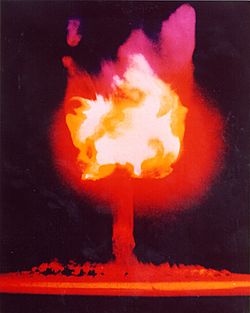Operation Ranger facts for kids
Quick facts for kids Operation Ranger |
|
|---|---|
| Information | |
| Country | United States |
| Period | 1951 |
| Number of tests | 5 |
| Test type | free air drop |
| Max. yield | 22 kilotonnes of TNT (92 TJ) |
Operation Ranger was a series of five nuclear tests carried out by the United States in 1951. It was the fourth time the U.S. tested nuclear weapons and the first time these tests happened at the Nevada Test Site.
All the bombs were dropped from B-50D airplanes. They exploded in the air above an area called Frenchman Flat (also known as Area 5). These tests were important because scientists wanted to find ways to make new nuclear weapons using less of the expensive materials needed for them. The project was first called Operation Faust.
The exact spots where the bombs exploded are not known because they were dropped from planes. However, the planned target area was near 36°49′32″N 115°57′54″W / 36.82556°N 115.96500°W. For the Fox test, the target was moved slightly to protect the control center nearby.
Contents
What Was Operation Ranger?
Operation Ranger was a series of five nuclear tests. These tests helped scientists learn how to make nuclear weapons more efficient. They wanted to use smaller amounts of special nuclear materials. This was important for making new types of bombs.
The Tests of Operation Ranger
There were five main tests in Operation Ranger. Each test had a special name and happened on a different day.
Able Test
The Able test was the first one in the series. It happened on January 27, 1951. This was the first nuclear test over the main part of the United States since the Trinity test in 1945. The bomb used was a Mk-4 type. It had a power of 1 kiloton (kt). This means it had the same explosive power as 1,000 tons of TNT.
Baker Test
The Baker test took place on January 28, 1951. It also used a Mk-4 type. This bomb was more powerful than Able, with a yield of 8 kt. Scientists were testing how well a special part called an "initiator" worked.
Easy Test
The Easy test was conducted on February 1, 1951. It was another test of the Mk-4 type, similar to Able. Its power was 1 kt. This test helped scientists understand how to make the nuclear material come together properly for an explosion.
Baker 2 Test
The Baker 2 test happened on February 2, 1951. It was very similar to the first Baker test. It also had a yield of 8 kt. The goal of this test was to see if the results from the first Baker test could be repeated. This helps scientists make sure their designs are reliable.
Fox Test
The Fox test was the last and most powerful test in Operation Ranger. It happened on February 6, 1951. This test used a different type of bomb, the Mk-6. It had a much larger yield of 22 kt. This means it had the explosive power of 22,000 tons of TNT. The Fox test helped prove that the Mark 6 bomb design worked as expected.
See also
 In Spanish: Operación Ranger para niños
In Spanish: Operación Ranger para niños


